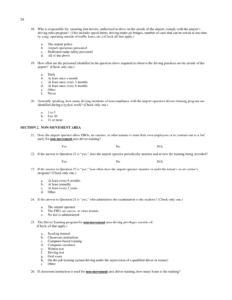Driver fatigue is a rampant issue that can lead to severe consequences, including accidents, injuries, and fatalities. Companies can implement a driver fatigue management policy template to combat this problem, ensuring the safety of their drivers and reducing the risk of fatigue-related incidents. This policy should outline strategies and procedures to identify, prevent, and mitigate driver fatigue, establishing a framework for managing and addressing this issue.
A driver fatigue management policy template guides organizations in developing a comprehensive plan to address driver fatigue. It provides guidelines for driver screening, work-hour limits, rest periods, education and training, fatigue monitoring, incident reporting, and enforcement. By following this template, companies can create a proactive approach to managing driver fatigue, fostering a culture of safety and compliance.
Key Elements of a Driver Fatigue Management Policy Template
1. Driver Screening and Assessment
The policy should include procedures for screening drivers to identify those at high risk of fatigue. This may involve health checks, sleep apnea screenings, and assessments of lifestyle factors that can contribute to fatigue. Additionally, the policy should outline criteria for determining driver fitness and establish processes for removing fatigued drivers from active duty.
The policy should define the maximum number of hours a driver may work in a day, week, and month. It should also specify the minimum rest periods required between shifts and the types of activities that constitute rest. The policy should consider factors such as the driver’s age, experience, and type of vehicle being operated.
Implementation and Enforcement of the Policy
1. Training and Education
The policy should require comprehensive training for drivers on fatigue management, focusing on recognizing signs of fatigue, understanding the consequences of fatigued driving, and adopting strategies to prevent and manage fatigue. Training should also cover topics such as sleep hygiene, healthy lifestyle habits, and the importance of seeking help when experiencing fatigue.
The policy should establish a system for monitoring driver fatigue and ensuring compliance with the policy’s provisions. This may involve using fatigue detection technology, conducting periodic driver checks, and reviewing driver logs and schedules. The policy should also define consequences for non-compliance, such as disciplinary action or suspension from driving duties.
Conclusion
A well-crafted driver fatigue management policy template can help organizations establish a comprehensive framework for addressing driver fatigue. By adopting this policy, companies can create a culture of safety and compliance, reducing the risk of fatigue-related incidents and ensuring the well-being of their drivers. Implementing a driver fatigue management policy template is a crucial step in promoting road safety and preventing fatigue-related accidents.
To further enhance the effectiveness of the policy, organizations should consider involving drivers in its development and implementation. This participatory approach can foster ownership and commitment among drivers, leading to greater adherence to the policy’s provisions and a more positive safety culture.
FAQ on Driver Fatigue Management Policy Template
1. What is a driver fatigue management policy template?
A driver fatigue management policy template is a comprehensive set of guidelines and procedures that organizations can use to develop and implement a driver fatigue management program. It includes strategies for identifying, preventing, and mitigating driver fatigue, ensuring the safety of drivers and reducing the risk of fatigue-related incidents.
2. What are the key elements of a driver fatigue management policy template?
The key elements of a driver fatigue management policy template include driver screening and assessment, work-hour limits and rest periods, training and education, fatigue monitoring, and enforcement mechanisms. These elements are essential for creating a comprehensive approach to managing driver fatigue and reducing the risk of fatigue-related incidents.
3. How can organizations use a driver fatigue management policy template?
Organizations can use a driver fatigue management policy template as a starting point for developing their own customized policy. They can adapt the template to suit their specific needs and circumstances, ensuring that it aligns with their operational requirements and regulatory obligations. By using a template, organizations can save time and effort while ensuring that they have a comprehensive policy in place to address driver fatigue.
